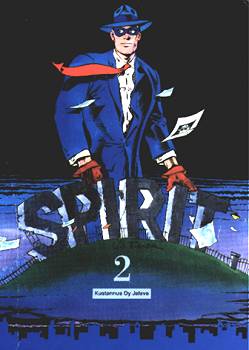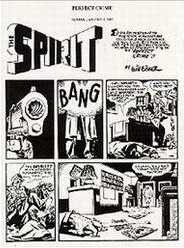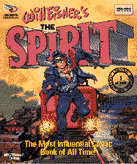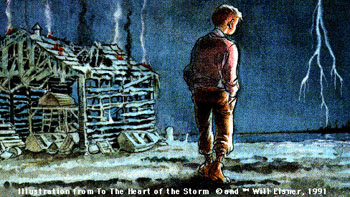

After some works as Sea Hawks and Sheena, queen of the jungle, Eisner had the idea of create a whole new character for the sunday series, not only one more colored suit super-hero, but someone who wouldn't even wear special clothes to fight criminals. He would wear civil clothes, a mask (which, years after, Eisner would confess hate to draw) to occult his secret identity, a hat, gloves and... nothing else that could identify him as a crime fighter.
 The
Spirit was a very odd story. Denny Colt, his secret identity,
lived in a cemetery, and had by sidekick a young black boy, the poor Ebony
White. He didn't have special powers nor gadgets to help him; he didn't
have even his own vehicle. His personal card was a small graveyard and
he wasn't always the winner in the end of the stories... The Spirit
could be defined as the common citizen fighting for his rights; only
his life was a little bit more funny because... he was a comic book character.
The
Spirit was a very odd story. Denny Colt, his secret identity,
lived in a cemetery, and had by sidekick a young black boy, the poor Ebony
White. He didn't have special powers nor gadgets to help him; he didn't
have even his own vehicle. His personal card was a small graveyard and
he wasn't always the winner in the end of the stories... The Spirit
could be defined as the common citizen fighting for his rights; only
his life was a little bit more funny because... he was a comic book character.
Formally, The Spirit meant a revolution in comic book language. Eisner explored each possibility and exhaled the use of each element of comic books: the balloon, the lettering, the caricature, the titles, the perspective, the text, the sequence, the splash page, etc. Every issue begun with a new and different logo for The Spirit, that merged with the backgrounds. And all this happened in Comic book childhood, what is even more relevant. Among his work's influences align Milton Cannif (Terry and the Pirates), George Herriman (Krazy Kat), Hal Foster (Prince Valiant), geniuses that deserve today the same acknowledgment than Eisner.
 Weekly tales' themes evolved from the mere super hero imbroglio
to the most sophisticated plots, to the limit when The Spirit, the
character who named the story, was only an extra. Eisner used the
7 pages to tell human dramas, personal delusions, easy romances, stuff
that happened in dailly life of any big city fellow, mixed with extraordinary
situations, tipically comic book. The boy who discover he can fly. A
message keeper who dies in the middle of a gangster war. A visit of the
aliens. One adventure in the desert, other in the North Pole,
other in the Far West. A killer who planned his murderers in a typewriter.
Radio advertisement. Ghost tales. Everything seemed fit in the seven pages,
and fitted very well.
Weekly tales' themes evolved from the mere super hero imbroglio
to the most sophisticated plots, to the limit when The Spirit, the
character who named the story, was only an extra. Eisner used the
7 pages to tell human dramas, personal delusions, easy romances, stuff
that happened in dailly life of any big city fellow, mixed with extraordinary
situations, tipically comic book. The boy who discover he can fly. A
message keeper who dies in the middle of a gangster war. A visit of the
aliens. One adventure in the desert, other in the North Pole,
other in the Far West. A killer who planned his murderers in a typewriter.
Radio advertisement. Ghost tales. Everything seemed fit in the seven pages,
and fitted very well.
 The
Spirit begun in 1941. In 1943 Eisner was drafted, and the story
continued with the help of his assistants, Jules Feiffer, Lou
Fine, Andre LeBlanc, Jack Cole. In 1946 he resumed his
job, still with their help, and ended in 1952, when he dedicated to apply
his knowledge about comic book in other media: publicity, story board,
educational. In the decades of 60's and 70's, has been teaching in Schools
of Art, and, in late seventies, decided came back to his most famous occupation.
The
Spirit begun in 1941. In 1943 Eisner was drafted, and the story
continued with the help of his assistants, Jules Feiffer, Lou
Fine, Andre LeBlanc, Jack Cole. In 1946 he resumed his
job, still with their help, and ended in 1952, when he dedicated to apply
his knowledge about comic book in other media: publicity, story board,
educational. In the decades of 60's and 70's, has been teaching in Schools
of Art, and, in late seventies, decided came back to his most famous occupation.
Almost a four part novel, but graphically told, A Contract with God was what he chose call a graphic novel, a term that would be very know years after. Totally different of the early works, A Contract with God tells the life of some inhabitants of a tenement in the Bronx, next to the neighborhood where Eisner really lived. An alley singer; the holidays away from the city; the supper, the so called contract with God.
The Contract is a landmark in Eisner career. A lot of graphic novels would come after, initially centered in the Bronx neighborhood memories. Life Force, abut the way people lived along the depression, in the thirties; A Signal from Space, science fiction tale about the cold war, politics, spies and a supposed alien contact; The Building, the life of four people and how it related with a single building; The Dreamer, about his years as a rookie artist, with many mentions to the ones that worked with him; To the Heart of the Storm, his autobiographic essay; Invisible People, about that persons that are lost in the crowd; Dropsie Avenue, the evolution of this neighborhood along the the years, and many other, published by Kitchen Sink Press.

Mature and dense works, to be read with care. Eisner can transmit completely the feelings in depression era, the difficulties of being a jew in US, the gossips in a neighborhood, nostalgia, kids' plays, urban life. His comics are as informative as any good book, and the art owes nothing to the better artists of the field. Eisner always worked in black and white, except in A Signal, colorized by Andre LeBlanc. His pages doesn't need colors, although he has already experimented with airbrush effects and water color in... b/w.
Will Eisner was born in 1917, and has already passed his 80th.
![]() Return
Return